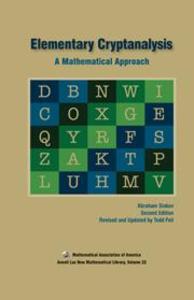
Zustellung: Fr, 02.05. - Mi, 07.05.
Versand in 3 Wochen
VersandkostenfreiBestellen & in Filiale abholen:
An introduction to the basic mathematical techniques involved in cryptanalysis.
Inhaltsverzeichnis
Part I. Monoalphabetic Ciphers: 1. The Caesar cipher; 2. Modular arithmetic; 3. Additive alphabets; 4. Solution of additive alphabets; 5. Frequency considerations; 6. Multiplications; 7. Solution of multiplicative alphabets; 8. Affine ciphers; Part II. General Substitution: 9. Mixed alphabets; 10. Solution of mixed alphabet ciphers; 11. Solution of five-letter groupings; 12. Monoalphabets with symbols; Part III. Polyalphabetic Substitution: 13. Polyalphabetic ciphers; 14. Recognition of polyalphabetic ciphers; 15. Determination of number of alphabets; 16. Solutions of additive subalphabets; 17. Mixed plain sequences; 18. Matching alphabets; 19. Reduction to a monoalphabet; 20. Mixed cipher sequences; 21. General comments; Part IV. Polygraphic Systems: 22. Linear transformations; 23. Multiplication of matrices - inverses; 24. Involutory transformations; 25. Recognition of digraphic ciphers; 26. Solution of a linear transformation; 27. How to make the Hill system more secure; Part V. Transposition: 28. Columnar transposition; 29. Completely filled rectangles; 30. Incompletely filled rectangles; 31. Probable word method; 32. General case; 33. Identical length messages; Part VI. RSA Encryption: 34. Public-key encryption; 35. The RSA method; 36. Creating the RSA keys; 37. Why RSA works - Fermat's Little Theorem; 38. Computational considerations; 39. Maple and Mathematica for RSA; 40. Breaking RSA and signatures; Part VII. Perfect Security - One-Time Pads: 41. One-time pads; 42. Pseudo-random number generators; A. Tables; B. ASCII codes; C. Binary numbers; D. Solutions to exercises; Further readings; Index.
Produktdetails
Erscheinungsdatum
06. August 2009
Sprache
englisch
Auflage
2nd Revised edition
Seitenanzahl
224
Autor/Autorin
Abraham Sinkov
Übersetzung
Todd Feil
Verlag/Hersteller
Produktart
gebunden
Gewicht
422 g
Größe (L/B/H)
235/159/20 mm
ISBN
9780883856475
Bewertungen
0 Bewertungen
Es wurden noch keine Bewertungen abgegeben. Schreiben Sie die erste Bewertung zu "Elementary Cryptanalysis" und helfen Sie damit anderen bei der Kaufentscheidung.









